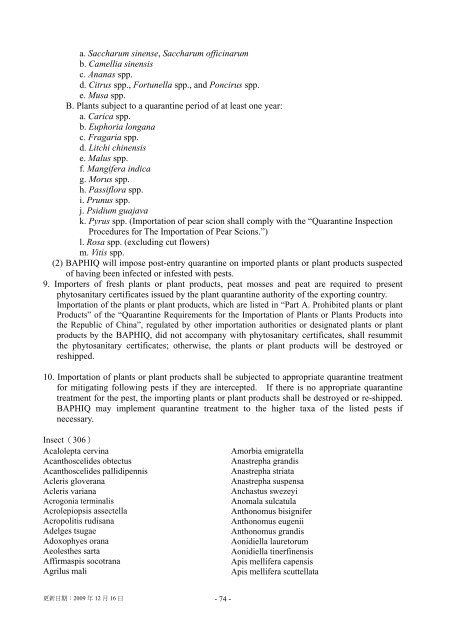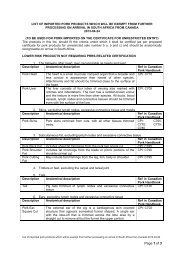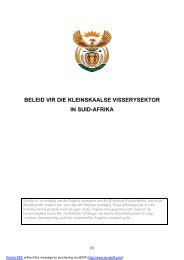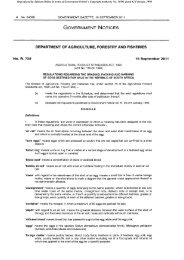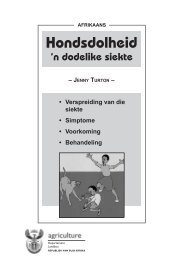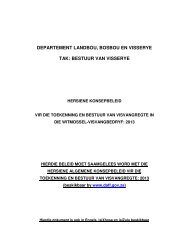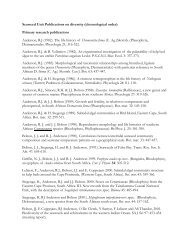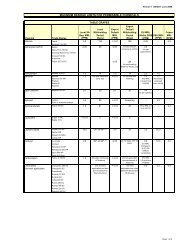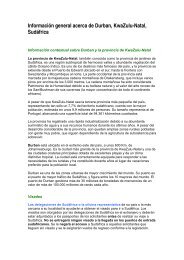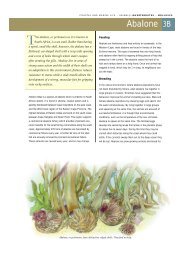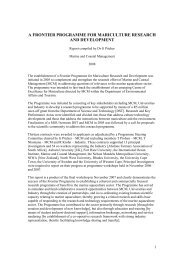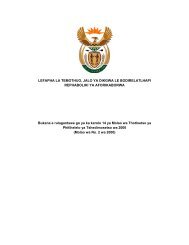Quarantine Regulation for Importation of Plants and
Quarantine Regulation for Importation of Plants and
Quarantine Regulation for Importation of Plants and
Create successful ePaper yourself
Turn your PDF publications into a flip-book with our unique Google optimized e-Paper software.
a. Saccharum sinense, Saccharum <strong>of</strong>ficinarum<br />
b. Camellia sinensis<br />
c. Ananas spp.<br />
d. Citrus spp., Fortunella spp., <strong>and</strong> Poncirus spp.<br />
e. Musa spp.<br />
B. <strong>Plants</strong> subject to a quarantine period <strong>of</strong> at least one year:<br />
a. Carica spp.<br />
b. Euphoria longana<br />
c. Fragaria spp.<br />
d. Litchi chinensis<br />
e. Malus spp.<br />
f. Mangifera indica<br />
g. Morus spp.<br />
h. Passiflora spp.<br />
i. Prunus spp.<br />
j. Psidium guajava<br />
k. Pyrus spp. (<strong>Importation</strong> <strong>of</strong> pear scion shall comply with the “<strong>Quarantine</strong> Inspection<br />
Procedures <strong>for</strong> The <strong>Importation</strong> <strong>of</strong> Pear Scions.”)<br />
l. Rosa spp. (excluding cut flowers)<br />
m. Vitis spp.<br />
(2) BAPHIQ will impose post-entry quarantine on imported plants or plant products suspected<br />
<strong>of</strong> having been infected or infested with pests.<br />
9. Importers <strong>of</strong> fresh plants or plant products, peat mosses <strong>and</strong> peat are required to present<br />
phytosanitary certificates issued by the plant quarantine authority <strong>of</strong> the exporting country.<br />
<strong>Importation</strong> <strong>of</strong> the plants or plant products, which are listed in “Part A. Prohibited plants or plant<br />
Products” <strong>of</strong> the “<strong>Quarantine</strong> Requirements <strong>for</strong> the <strong>Importation</strong> <strong>of</strong> <strong>Plants</strong> or <strong>Plants</strong> Products into<br />
the Republic <strong>of</strong> China”, regulated by other importation authorities or designated plants or plant<br />
products by the BAPHIQ, did not accompany with phytosanitary certificates, shall resummit<br />
the phytosanitary certificates; otherwise, the plants or plant products will be destroyed or<br />
reshipped.<br />
10. <strong>Importation</strong> <strong>of</strong> plants or plant products shall be subjected to appropriate quarantine treatment<br />
<strong>for</strong> mitigating following pests if they are intercepted. If there is no appropriate quarantine<br />
treatment <strong>for</strong> the pest, the importing plants or plant products shall be destroyed or re-shipped.<br />
BAPHIQ may implement quarantine treatment to the higher taxa <strong>of</strong> the listed pests if<br />
necessary.<br />
Insect(306)<br />
Acalolepta cervina<br />
Acanthoscelides obtectus<br />
Acanthoscelides pallidipennis<br />
Acleris gloverana<br />
Acleris variana<br />
Acrogonia terminalis<br />
Acrolepiopsis assectella<br />
Acropolitis rudisana<br />
Adelges tsugae<br />
Adoxophyes orana<br />
Aeolesthes sarta<br />
Affirmaspis socotrana<br />
Agrilus mali<br />
更新日期:2009 年 12 月 16 日<br />
- 74 -<br />
Amorbia emigratella<br />
Anastrepha gr<strong>and</strong>is<br />
Anastrepha striata<br />
Anastrepha suspensa<br />
Anchastus swezeyi<br />
Anomala sulcatula<br />
Anthonomus bisignifer<br />
Anthonomus eugenii<br />
Anthonomus gr<strong>and</strong>is<br />
Aonidiella lauretorum<br />
Aonidiella tinerfinensis<br />
Apis mellifera capensis<br />
Apis mellifera scuttellata


